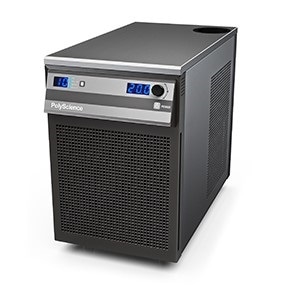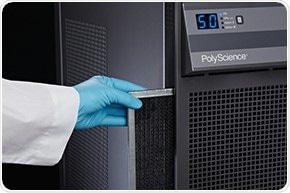Precise temperature control is essential for MS to work optimally and provide accurate GC-MS results. Recirculating chillers from PolyScience are the ideal solution for cooling the MS component of GC-MS equipment.
GC-MS (gas chromatography-mass spectrometry) is an essential analytical tool in many areas of industry and academic research. GC-MS can identify and quantify compounds present in a mixture by first separating the compounds using GC, and then identifying the compounds using MS.

6000 series chillers from PolyScience. Image credit: PolyScience
GC-MS is one of the most widely used analytical techniques in academia and industry. The combination of gas chromatography and mass spectrometry offered by GC-MS allows it to identify and quantify substances in a test sample, even if they are only present in tiny amounts.
GC-MS offers a range of advantages over other techniques; it is a well-used and mature technique, so equipment is often affordable, durable and easy to use. What’s more, there are many well-developed analysis methods for GC-MS and well-populated databases, making method development and analyte identification quick and easy. It is not surprising, therefore, that GC-MS has found a range of applications in quality control, food science, toxicology, explosive detection, security, environmental monitoring, forensic science, biological analysis, pharmaceuticals, astrochemistry, geochemistry, petrochemistry, and fuel chemistry.
Combining Gas chromatography and mass spectrometry to complement each other
GC-MS uses two individual analytical techniques, gas chromatography (GC) and mass spectrometry (MS), to analyze complex mixtures. First, GC separates the compounds with high resolution, then MS provides detailed structural information about the compounds, allowing them to be individually identified and quantified.
GC and MS are highly compatible techniques and work well in tandem; they both analyze vapor phase compounds, and typically deal with the same amount of sample, allowing them to be combined into one technique using one piece of equipment without interruption.
How does gas chromatography work?
A sample is injected into the GC, where it is vaporized and enters a column, which contains the stationary phase, often a solid support coated with a non-volatile liquid. The sample is then swept through the column by the mobile phase, usually an inert or unreactive carrier gas, such as helium or nitrogen. The compounds present in the sample are separated by the time it takes them to pass through the column, and the GC produces a spectral output with peaks at different retention times corresponding to individual compounds.
While retention times can aid in differentiating between some compounds, retention times can be the same for two compounds, meaning that GC analysis alone it is not a reliable way to identify a compound.
How does mass spectrometry work?
Once GC has separated the compounds in the mixture, they can be identified using MS. Typical MS instruments contain a sample inlet, an ionization source, a molecule accelerator, and a detector. The sample enters the inlet, which is maintained at a high temperature to ensure the sample remains a gas.
The compound is then ionized in the ionization chamber, typically by bombarding it with high energy electrons, causing the compound to shatter into charged fragments. The charged fragments then travel through the accelerator. As the fragments reach the detector, their mass and charge are determined to produce a mass spectrum, showing the ion signal of each fragment as a mass-to-charge ratio, which can be used to determine the structure of the original compounds.
Sufficient cooling of MS components is vital for GC-MS systems
Thermal management of GC-MS systems is a critical component of the system design process. Ionization and acceleration of analytes using MS are energetic processes that result in heat production. However, both the GC and MS components of GC-MS systems require precise, stable temperature control to achieve maximum efficiency and accuracy. MS components of GC-MS systems, particularly the magnetic coils and molecular pumps, require cooling systems to maintain optimal working temperatures.
Although GC-MS is widely believed to provide accurate and reliable analysis, a study published in Analytical Chemistry in 2015 suggests that exposure to increased temperatures during GC-MS analysis can cause analyte degradation, resulting in distorted data and unreliable results. Proper MS cooling ensures accurate results, optimizes GC-MS performance, and extends the system lifetime.

Image credit: PolyScience
Recirculating chillers, such as those from PolyScience, provide circulated cooling to keep the MS component of GC-MS systems at the optimal temperature. PolyScience has been the market leader in liquid temperature control equipment for 50 years, and their recirculating chillers can be integrated into a range of GC-MS systems.
PolyScience chillers provide reliable and flexible temperature control over a wide range of temperatures from -10° to +70 °C with cooling capacities up to 2900 W, quietly and effectively keeping the system operating at its best. The 6000 series chillers are models, so you are certain to find the ideal solution in your lab for your GC-MS system with PolyScience.
References and Further Reading:
- ‘Handbook of GC/MS: Fundamentals and Applications’ — H-J Hübschmann, Wiley, 2008.
- ‘Gas Chromatography-Mass Spectrometry: Applications’ — K Sahil, B Prashant, M Akanksha, S Premjeet, R Devashish, International Journal of Pharmaceutical & Biological Archives, 2011.
- ‘Gas Chromatography‐Mass Spectrometry‐Basic Principles, Instrumentation and Selected Applications for Detection of Organic Compounds’ — J Sneddon, S Masuram, JC Richert, Analytical Letters, 2007.
- ‘Gas Chromatography Mass Spectrometry’ in ‘Handbook of Instrumental Techniques for Analytical Chemistry’ — FA Settle, Prentice Hall, 1997.
- ‘GC-MS Technique and its Analytical Applications in Science and Technology’ — A Chauhan, MK Goyal, P Chauhan, Journal of Analytical & Bioanalytical Techniques, 2014.
- ‘Thermal Degradation of Small Molecules: A Global Metabolomic Investigation’ — M Fang, J Ivanisevic, HP Benton, CH Johnson, GJ Patti, LiT Hoang, W Uritboonthai, ME Kurczy, G Siuzdak, Analytical Chemistry, 2015.
- ‘Chillers and Coolers’ https://www.polyscience.com/products/chillers/6000-series
About Polyscience

PolyScience was started in 1963. They pioneered innovations ranging from the first zero-switching circulators to the first refrigeration systems for DNA amplification to an award-winning line of culinary products.
Sponsored Content Policy: News-Medical.net publishes articles and related content that may be derived from sources where we have existing commercial relationships, provided such content adds value to the core editorial ethos of News-Medical.Net which is to educate and inform site visitors interested in medical research, science, medical devices and treatments.